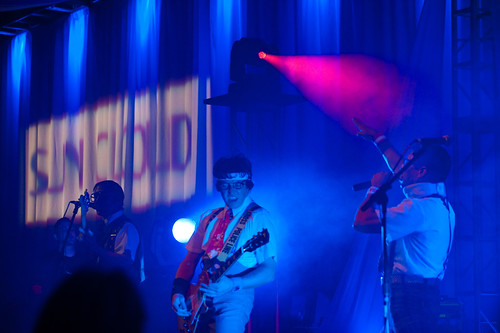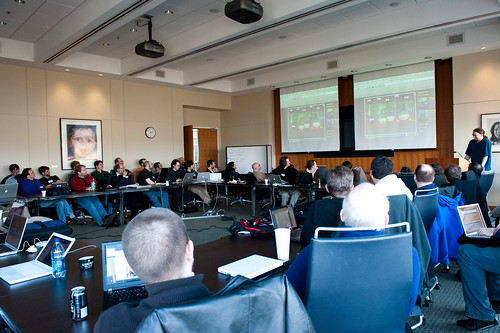This was my second year attending these events as a Sun employee. Everything in software at Sun seems to revolve around these two events. For quite some time before the show, people are working away furiously getting things ready to be unveiled, myself included.
CommunityOne
For me, the big theme at CommunityOne was cloud computing. Sun itself was emphasizing cloud stuff and the latest release of OpenSolaris, 2009.06, which were the main topics of the CommunityOne general session. The Sun Cloud is due out sometime this summer, so much of the cloud part of the session was having partners come up and tell about their experiences working with our cloud. The OpenSolaris team has done a huge amount of work in 2009.06. The feature that stuck out to me the most is “Crossbow“, which is a completely rewritten networking stack. Solaris already had CPU virtualization technology built into it via the zones feature. Crossbow makes it possible to virtualize networking configurations. This means that you could run an instance of OpenSolaris on your laptop (either natively or via VirtualBox, VMWare or whatever) and actually have a virtualized data center configuration running right there. That’s pretty interesting stuff.
I went to several cloud sessions, and I’d have to say that the current state of cloud computing is pretty rough. At least that’s true at the Infrastructure as a Service level where Amazon and the Sun Cloud are. As an example, I went to a good presentation by fellow Sun employees on cloud computing patterns. I happened to be sitting with James Governor and Stephen O’Grady of Redmonk, and I turned to Stephen and said “these patterns are all at a level that I never want to have to worry about”. The patterns themselves were fine, but I personally don’t want to have to deal with things at that level in a cloud platform. There is lots of room for improvement and innovation in this space.
My CommunityOne talk was called “Programming Languages for the Cloud”.
The talk is based on my experience as a language guy who has been asked to work on cloud computing stuff. As such, I’m really trying to raise questions (for which I don’t yet have answers) about places where work on programming languages might usefully intersect with cloud computing. I figured that this would be a niche kind of talk, so I was very surprised to find myself in one of the larger rooms at Moscone, complete with a live video feed. I was even more surprised to see that the room was pretty full. After the presentation, one of the Salesforce.com engineers working on Apex (their domain specific language for the cloud) came up to the front. We ended up having lunch and I learned a bunch interesting stuff about their experience withe Apex. This sort of thing is what makes conferences worthwhile.
JavaOne
I spent the first day of JavaOne prepping for my presentation, “Seeding the Cloud”, which was about some ways that tools could help developers who choose to build applications in the cloud.
Ashwin Rao and I had some pretty interesting demos lined up, but we had problems with the internet connection in the room so a number of the demos failed. I learned later that the internet connection for all of Moscone Center had gone out, which made me feel slightly better. As someone commented to me, it was a good illustration of some of the weak points of the cloud (web, really) model.
The demonstration that I really wanted to show was an extension of some work that the
Kenai team has done. Kenai is going to have support for doing continuous integration via Hudson, and the machines for doing that can be allocated as cloud instances. This is great if you have a project in Java or some other language that has major build steps. Another use for a dynamically allocated farm of machines is to do web UI testing on browser combinations. Back at PyCon, I put a bug into
Adam Christian and
Mikeal Roger‘s ears about this. Adam and Mikeal are the primary guys behind the
Windmill web UI testing framework. Adam has been working with
Hudson author
Kohsuke Kawaguchi, and between the two of them they came up with a way for Hudson to start up a bunch of different browsers on different operating systems. If my demo had worked, people would have seen me kick off a Hudson build from inside of Netbeans 6.7, and then we would have watched (via RDC) the various browsers running though some UI tests on a web application. Oh well.
I spent the rest of JavaOne ducking into various language and concurrency talks. Jonas Boner gave a very nice talk comparing some of the concurrency mechanisms that are available on the JVM. Alex Miller gave a talk on Java concurrency gotchas. The net effect of Alex’s talk was to reinforce the fact that we need one or more of the mechanisms that Jonas covered in his talk. Also in the concurrency vein, I stopped in on Philipp Haller and Frank Sommer’s ‘s talk on Scala Actors. Probably the most fun concurrency thing was a random conversation with Clojure author Rich Hickey and Jonas Boner in the speaker room.
JavaOne is big on the keynote / general sessions. I only went to two, the opening session, and Bob Brewin’s technical keynote. The big news (to me) in Bob’s keynote was Mark Reinhold’s demonstration of a modularized JDK. This is cool for a variety of reasons, like reducing the footprint of the downloads, ability to build distribution packages trivially, and so forth. But the thing that made me happies was news that the CLASSPATH is finally going way, to be replaced by a module-info.java file.
The opening general session was very subdued. There were a variety of partner / sponsor segments, but things were really running at a low energy level until the end when Scott McNealy took the stage and then introduced Oracle CEO Larry Ellison. Despite Ellison’s reassurances to the Java community, it was a sad moment. I’ve only been at Sun for a little over a year, but my history with the company is pretty long. When I was in grad school, Brown was on of the first large installations of Solaris (replacing SunOS). Like many developers, I’ve used Java over the years. Sun has made a number of very important contributions to the computer industry, and it’s sad to me that a company so full of innovation was unable to remain independent.
Photography
This year things were so busy and frenetic that I really didn’t have much time to pull out the camera. Between presentations and meeting up with Sun people from all over the world, there just wasn’t time. Here are a few from the few times that my camera escaped its bag:
Bob Brewin’s Technical Keynote
The Extra Action Marching Band on the CommunityOne Expo Floor
The CommunityOne Party
The CommunityOne Party
The CommunityOne Party
The CommunityOne Party

The CommunityOne Party

The CommunityOne Party








